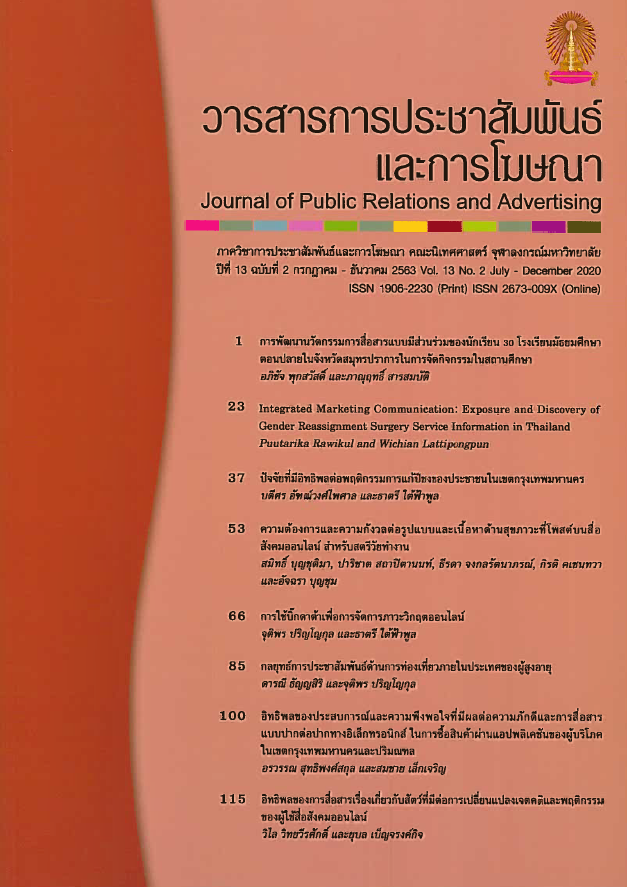ปัจจัยที่มีอิทธิพลต่อพฤติกรรมการแก้ปีชงของประชาชนในเขตกรุงเทพมหานคร
Main Article Content
บทคัดย่อ
การวิจัยครั้งนี้มีวัตถุประสงค์เพื่อศึกษาการเปิดรับสื่อ ทัศนคติ และพฤติกรรมในการแก้ปีชงของประชาชนในเขตกรุงเทพมหานคร งานวิจัยชิ้นนี้เป็นการวิจัยเชิงปริมาณ โดยใช้วิธีวิจัยเชิงสำรวจ ด้วยเครื่องมือการเก็บข้อมูลจากแบบสอบถาม จำนวนทั้งสิ้น 400 คน ซึ่งบุคคลนั้นจะเป็นผู้ที่เคยแก้ปีชง จำนวน 200 คน และไม่เคยแก้ปีชง จำนวน 200 คน ด้วยวิธีการสุ่มตัวอย่างแบบง่าย โดยการจับฉลากมา 4 เขต จากทั้งหมด 50 เขตในกรุงเทพมหานคร ซึ่งจะประมวลผลโดยใช้โปรแกรม SPSS วิเคราะห์ข้อมูลสถิติเชิงบรรยาย และการใช้สถิติเชิงอนุมาน ด้วยค่าสถิติ t-test ร่วมกับการวิเคราะห์ความแปรปรวนแบบ One Way ANOVA และค่าความสัมพันธ์แบบ Multiple Regression Analysis ผลการวิจัยพบว่าผู้ที่เคยแก้ปีชงและไม่เคยแก้ปีชงนั้นมีการเปิดรับสื่อ ทัศนคติ แลtพฤติกรรมในการแก้ปีชงที่แตกต่างอย่างมีนัยสำคัญที่ 0.001 สำหรับผู้ที่เคยแก้ปีชงนั้นมีการเปิดรับสื่อและความถี่เกี่ยวกับการแก้ปีชงประเภทสื่อมวลชนในระดับต่ำ ประเภทสื่อรูปแบบใหม่อยู่ในระดับปานกลาง และประเภทสื่อบุคคลในระดับปานกลาง โดยมีทัศนคติเกี่ยวกับความเชื่อเรื่องปีชงระดับเชื่อมั่นปานกลาง ทั้งนี้ผู้ที่เคยแก้ปีชงนั้นมีพฤติกรรมในการแก้ปีชงในระดับปานกลาง ซึ่งจะมีค่าใช้จ่ายในการแก้ปีชงอยู่ที่ 101 – 500 บาท สำหรับผู้ที่ไม่เคยแก้ปีชงนั้นมีการเปิดรับสื่อและความถี่เกี่ยวกับการแก้ปีชงประเภทสื่อมวลชนในระดับต่ำ ประเภทสื่อรูปแบบใหม่ในระดับต่ำ และประเภทสื่อบุคคลในระดับต่ำ โดยทัศนคติเกี่ยวกับความเชื่อเรื่องปีชงระดับไม่เชื่อมั่น ทั้งนี้ผู้ที่ไม่เคยแก้ปีชงนั้นมีพฤติกรรมในการไปแก้ปีชง (ที่คาดว่าจะทำเมื่อไปแก้ปีชง) ในระดับต่ำ ซึ่งจะมีค่าใช้จ่ายที่คิดจะไปแก้ปีชงอยู่ที่ต่ำกว่า 100 บาท
Article Details
เอกสารอ้างอิง
กิ่งแก้ว ทรัพย์พระวงศ์. (2546). จิตวิทยาทั่วไป. กรุงเทพฯ: ไทยเจริญการพิมพ์.
ขวัญเรือน กิติวัฒน์. (2531). สื่อมวลชนกับการสร้างความเป็นจริงทางสังคม. วารสารนิเทศศาสตร์: จุฬาลงกรณ์มหาวิทยาลัย.
ถาวร สิกขโกศล. (2559). ชงในภาษาและวัฒนธรรมจีน. ศิลปวัฒนธรรม. (37)4.
ถาวร สิกขโกศล. (2560). ความรู้เรื่องชงและเรื่องน่ารู้จีน-ไทย. กรุงเทพฯ: แสงดาว.
ธีระภัทร์ เอกผาชัยสวัสดิ์. (2551). ประชากรศึกษา. วันที่เข้าถึงข้อมูล 20 พฤษภาคม 2562, แหล่งที่มา http://computer.pcru.ac.th/%20emoodledata/19/
นฤมล หิญชีระนันท์. (2541). ร่างรายงานผลการวิจัยฉบับสมบูรณ์ ชุดโครงการประเมินสถานภาพ ไทยศึกษาเอกสารหมายเลข 3 ความเชื่อทางศาสนาและพิธีกรรม. กรุงเทพฯ: สำนักพิมพ์จุฬาลงกรณ์มหาวิทยาลัย.
ปรมะ สตะเวทิน. (2541). หลักนิเทศศาสตร์. กรุงเทพฯ: ห้างหุ้นส่วนจำกัด ภาพพิมพ์.
ปรมะ สตะเวทิน. (2546). การสื่อสารมวลชน: กระบวนการและทฤษฎี. กรุงเทพฯ: ห้างหุ้นส่วนจำกัด ภาพพิมพ์.
ปรีชา วิหคโต. (2532). แนวการศึกษาบุคลิกภาพ. นนทบุรี: มหาวิทยาลัยสุโขทัยธรรมาธิราช.
ปีชง. (2562). วันที่เข้าถึงข้อมูล 17 พฤษภาคม 2562, แหล่งที่มา https://www.sanook.com/horoscope/search/ปีชง/
พรพรรณ จันทโรนานนท์. (2539). ฮก ลก ซิ่ว โชค ลาภ อายุยืน. กรุงเทพฯ: มติชน.
พรพรรณ จันทโรนานนท์. (2562). ชาวจีนในไทยมาจากไหน. วันที่เข้าถึงข้อมูล 15 พฤษภาคม 2562, แหล่งที่มา https://www.silpa-mag.com/history/article_26173
พฤติกรรมการทำบุญของคนไทย. (2548). วันที่เข้าถึงข้อมูล 15 พฤษภาคม 2562, แหล่งที่มา https://positioningmag.com/
มณี พยอมยงค์. (2530). ความเชื่อของคนไทยใน วัฒนธรรมพื้นบ้าน : คติความเชื่อ. กรุงเทพฯ: จุฬาลงกรณ์มหาวิทยาลัย.
ศักดิ์ สุนทรเสณี. (2531). เจตคติ. กรุงเทพฯ: ดี.ดี.บุ๊คสโตร์.
ศิริวรรณ เสรีรัตน์. (2538). ทฤษฎีด้านประชากรศาสตร์. กรุงเทพฯ: พัฒนาการศึกษา.
เศรษฐพงษ์ จงสงวน. ที่ปรึกษา วัดทิพยวารีวิหาร. (22 พฤษภาคม 2562). สัมภาษณ์.
สร้อยสุดา ไชยเหล็ก. (2558). ตำนานไท้ส่วยเอี๊ยะ 60 องค์และพิธีแก้ปีชงในศาสนสถานจีนในสังคมไทยร่วมสมัย. วิทยานิพนธ์ปริญญามหาบัณฑิต. จุฬาลงกรณ์มหาวิทยาลัย.
สิรินันท์ บินรอซา. (2551). การเปิดรับข่าวสาร ความรู้ ทัศนคติ และการมีส่วนร่วมในการใช้ผลิตภัณฑ์อนุรักษ์สิ่งแวดล้อมของบุคลากรบริษัทเอกชนในเขตกรุงเทพมหานคร. วิทยานิพนธ์ปริญญามหาบัณฑิต. จุฬาลงกรณ์มหาวิทยาลัย.
สุเทพ สุนทรเภสัช. (2525). "ความเชื่อในเรื่องผีปู่ตา หมู่บ้านภาคตะวันออกเฉียงเหนือ," ในสังคมวิทยาของหมู่บ้านภาคตะวันออกเฉียงเหนือ. กรุงเทพฯ: สมาคมสังคมศาสตร์แห่งประเทศไทย.
สุรพงษ์ โสธนะเสถียร. (2533). การสื่อสารเพื่อการจัดการในองค์การธุรกิจ. กรุงเทพฯ: สำนักงานกองทุนสนับสนุนการวิจัย.
สุรพล พยอมแย้ม. (2545). ปฏิบัติการจิตวิทยาในงานชุมชน. กาญจนบุรี: สหายพัฒนาการพิมพ์.
เสฐียรโกเศศ. (2510). ชีวิตคนไทยสมัยก่อน. กรุงเทพฯ: บรรณาคาร.
แสง จันทร์งาม. (2534). ศาสนาศาสตร์. กรุงเทพฯ: ไทยวัฒนาพานิช.
อาทิตยา เข็มทอง. (2552). การเปิดรับสื่อการทำนายดวงชะตา ทัศนคติและพฤติกรรมการใช้บริการทำนายดวงชะตาของคนกรุงเทพฯ. วิทยานิพนธ์ปริญญามหาบัณฑิต. จุฬาลงกรณ์มหาวิทยาลัย.
Becker, S. L. (1978). Discovering Mass Communication. Illinois: Scott Foreman and Glenwave.
Hawkins, D. I., & Mothersbaugh, D. L. (2010). Consumer Behavior: Building Marketing Strategy. Boston: McGraw-Hill Irwin.
Hoyer, D. W., & MacInnis, D. J. (2001). Consumer behavior Boston: Houghton Mifflin.
Klapper, & Joseph. (1960). The Effects of Communication. New York: The Free Press.
Munn, N. L. (1971). introduction to psychology. Boston Hougston Miffin Company.
Schermerhorn, J. R., Osborn, R. N., & Hunt, J. G. (2000). Organizational behavior. New York: J. Wiley.
Triandis, H. C. (1971). Attitde and Attituse Change. New York: John Wiley & Sons Inc.


